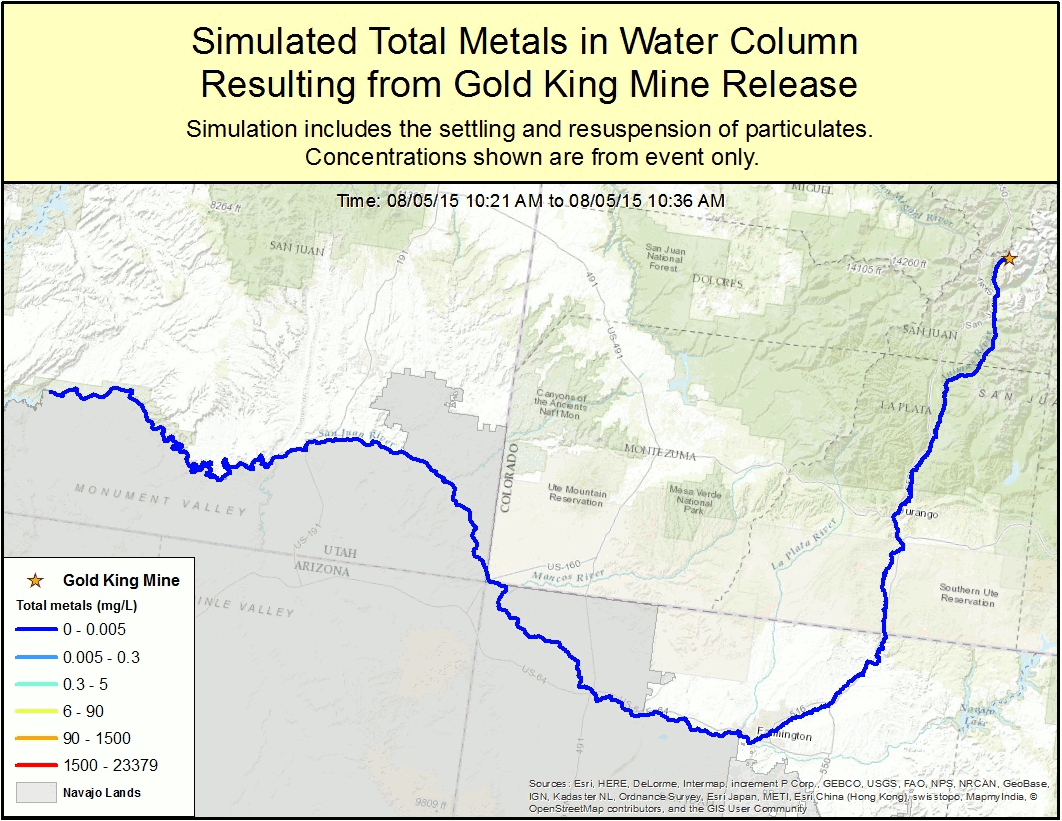Fate & Transport Analysis
January 6, 2017: EPA's Office of Research and Development has finalized the report “Analysis of the Transport and Fate of Metal Released from the Gold King Mine in the Animas and San Juan Rivers.” The report is a scientific analysis that focuses on understanding the river conditions before the GKM release; the movement of the GKM release through the river system; and what has happened to water quality in the river since the time of the GKM release.
The research supports EPA’s earlier statements that water quality in the affected river system returned to the levels that existed prior to the GKM release and contamination of metals from the release have been moved through the river system to Lake Powell.
- Executive Summary (PDF) (6pp, 510K, About PDF), “Analysis of the Transport and Fate of Metals Released from The Gold King Mine in the Animas and San Juan Rivers”
- Full Report (PDF) (328pp, 23M, About PDF), “Analysis of the Transport and Fate of Metals Released from The Gold King Mine in the Animas and San Juan Rivers”
Summary of key findings from the fate and transport of the GKM event:
- This river system has a long history of leaking mine waste contamination from hundreds of old and abandoned mines throughout the region.
- EPA analysis indicates as of Fall 2016 contamination of metals from the GKM release have been transported through the Animas and San Juan River system to Lake Powell.
- The GKM release included aluminum, iron, manganese, lead, copper, arsenic, zinc, cadmium, and a small amount of mercury.
- The Gold King Mine release was equivalent to four to seven days of ongoing GKM acid mine drainage. The total amount of metals entering the Animas River following the 9-hour release was comparable to the amount of metals carried by the river in one to two days of high spring runoff. However, the concentrations of metals were higher than historical acid mine drainage.
- Samples collected did not exceed EPA’s recreational screening levels. Some metal concentrations contributed to sporadic exceedances of state and tribal water quality criteria at times for 9 months in some locations. EPA and states establish water quality standards based on the use of the water to protect human health and aquatic life. In addition to these factors, tribal standards also consider tribal cultural uses, and are often more stringent than state or federal standards. Thus, tribal standards were exceeded more often, even during average flow periods because of historical background contamination. Metals from the GKM release also may have contributed to some exceedances during the 2016 spring snow melt. Other exceedances may reflect longstanding issues of mining wastes in the region as well as natural levels of common elements such as aluminum and iron in soils and rocks in the area. EPA will continue to work with states and tribes to interpret and respond to these findings.
- The 2016 spring snowmelt remobilized the metals that had settled in the sediment throughout the river system. This was expected based on historic observations. Some of the metals were due to the GKM release. Concentrations of metals in both sediment and water returned to pre-event concentrations by the end of the snowmelt period.
- Ground water modeling suggests that a few wells located in the floodplain within 100 meters of the Animas River had the potential to draw river water, possibly including dissolved metals, during the time the GKM release plume passed. Most ground water in the affected area flows towards the river rather than from the river toward the wells. The concentrations of metals in well-water samples collected after the plume passed did not exceed federal drinking water standards.
- Results from this analysis will inform future monitoring by EPA, states and tribes, including decisions about what is monitored; where monitoring takes place; and when monitoring takes place.
- EPA is committed to working with States and Tribes in the areas affected by the Gold King Mine release to ensure the protection of public health and the environment.
Additional Materials
View an animation of the Gold King Mine plume

View a text version of this animation
Previously Released Draft Materials
